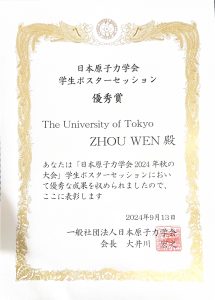2024年10月10日
【Awards and Commendations】ZHOU WEN, Okamoto/Miwa lab, Department of Nuclear Engineering and Management, (D2)
On 9/13/2024, ZHOU WEN, Okamoto/Miwa lab, Department of Nuclear Engineering and Management, (D2), received “The Atomic Energy Society of Japan 2024 Autumn Excellent Poster Award” at the Atomic Energy Society of Japan 2024 Autumn Meeting.
〈Name of award and short explanation about the award〉
I received the “The Atomic Energy Society of Japan 2024 Autumn Excellent Poster Award” (AESJ) for my outstanding contribution in developing and presenting a novel AI-driven approach for generating high-quality bubbly flow images using generative adversarial networks (GAN). This award recognizes innovative work that advances research and technology in atomic energy and related fields.
〈About awarded research〉
My award-winning research focuses on the development of a generative AI architecture called BF-GAN (Bubbly Flow Generative Adversarial Network), designed to generate realistic two-phase bubbly flow images. This work significantly reduces the time and cost associated with acquiring high-quality experimental data. The title of my presentation was “BF-GAN: Development of an AI-driven Bubbly Flow Image Generation Model Using Generative Adversarial Networks.” Below is the abstract of my report: BF-GAN: Development of an AI-driven Bubbly Flow Image Generation Model Using Generative Adversarial Networks
In recent years, image processing methods for gas-liquid two-phase flow, including conventional computer vision techniques, bubble detection, segmentation, and tracking algorithms, have seen significant development due to their high efficiency and accuracy. Nevertheless, obtaining extensive, high-quality two-phase flow images continues to be a time-intensive and costly process. To address this issue, a generative AI architecture called bubbly flow generative adversarial networks (BF-GAN) is developed, designed to generate realistic and high-quality bubbly flow images through physically conditioned inputs, namely superficial gas (j_g) and liquid (j_f) velocities.
Initially, 105 sets of two-phase flow experiments under varying conditions are conducted to collect 278,000 bubbly flow images with physical labels of j_g and j_f as training data. A multi-scale loss function of GAN is then developed, incorporating mismatch loss and feature loss to further enhance the generative performance of BF-GAN. The BF-GAN’s results indicate that it has surpassed conventional GAN in all generative AI indicators, establishing for the first time a quantitative benchmark in the domain of bubbly flow. In terms of image correspondence, BF-GAN and the experimental images exhibit good agreement. Key physical parameters of bubbly flow images generated by the BF-GAN, including void fraction, aspect ratio, Sauter mean diameter, and interfacial area concentration, are extracted and compared with those from experimental images. This comparison validates the accuracy of BF-GAN’s two-phase flow parameters with errors ranging between 2.3% and 16.6%. The comparative analysis demonstrates that the BF-GAN is capable of generating realistic and high-quality bubbly flow images for any given j_g and j_f within the research scope, and these images align with physical properties.
BF-GAN offers a generative AI solution for two-phase flow research, substantially lowering the time and cost required to obtain high-quality data. In addition, it can function as a benchmark dataset generator for bubbly flow detection and segmentation algorithms, enhancing overall productivity in this research domain. The BF-GAN model is available online (https://github.com/zhouzhouwen/BF-GAN).
〈Your impression & future plan〉
First off, I would like to express my gratitude to my supervisors Prof. Miwa, Prof. Okamoto, and Prof. Liu for their very patient guidance, support and encouragement during my research, this award is inseparable from their guidance. Looking forward, I aim to further refine the BF-GAN model to broaden its applicability across various types of two-phase flow systems, thereby contributing to a wider range of fluid dynamics research. I also hope to collaborate with other researchers to apply this model in practical industrial scenarios, such as nuclear reactor safety studies and chemical engineering processes. Winning this award inspires me to continue pushing the boundaries of AI-driven scientific research, and I am eager to see how this technology can advance our understanding of complex fluid dynamics.



